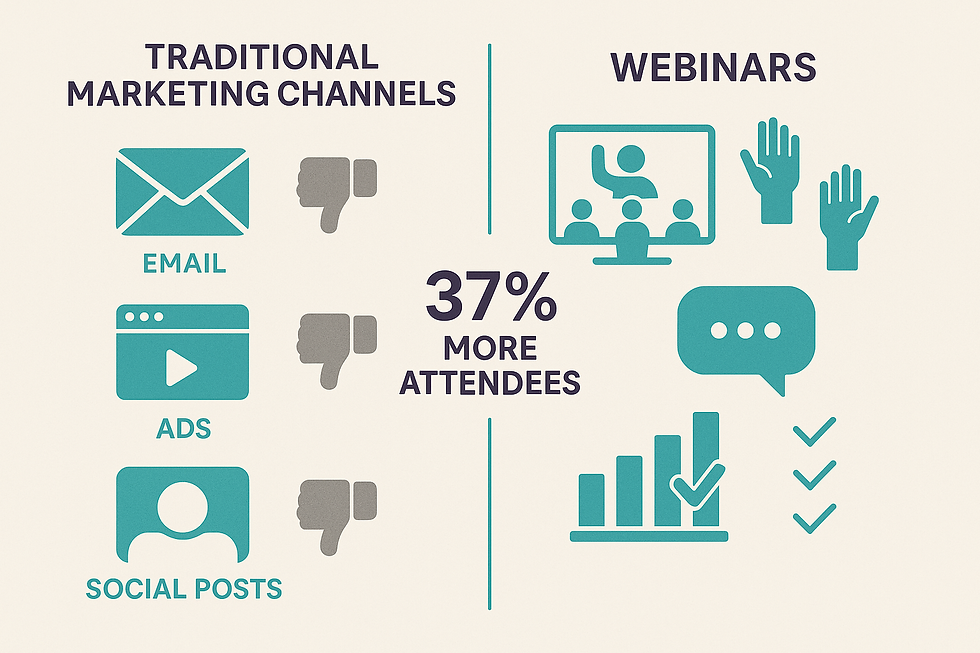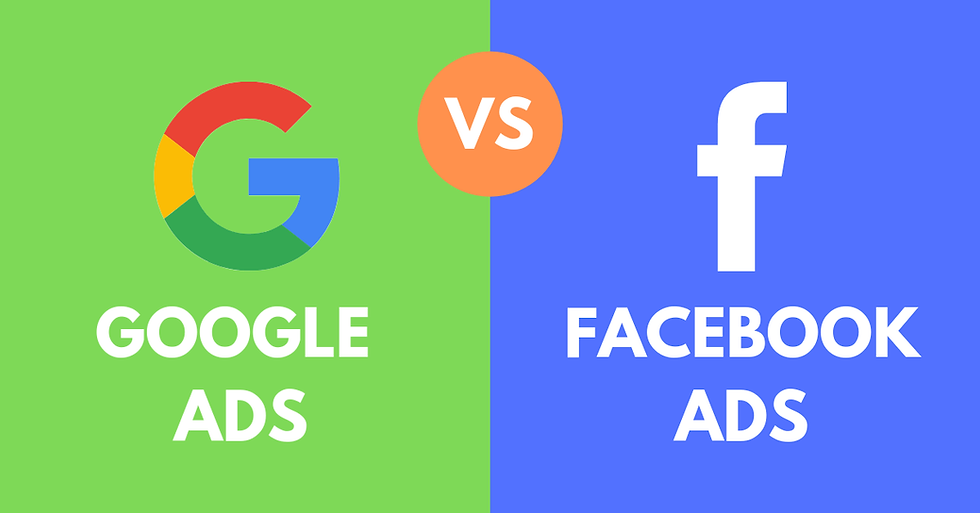Cracking the Webinar Code
- businessflipup
- Jun 20
- 6 min read
Updated: Jul 7
Have you ever joined a webinar because you genuinely wanted to learn something rather than being pushed into yet another sales pitch? The digital landscape is saturated with thousands of marketing tactics that most of us instinctively ignore or scroll past when they interrupt our browsing. Yet amidst this content overload, a select few brands create webinars so valuable and engaging that they make us eagerly block out time in our calendars and actually show up ready to participate.

These exceptional virtual events don't merely showcase products; they deliver genuine insights, solve real problems, and sometimes even transform how we approach our work entirely. Marketers invest in strategic webinar programs because they understand a crucial truth: bored audiences don't just leave early, they develop lasting negative impressions of brands that waste their time.
A webinar that feels like a thinly disguised sales presentation creates resentment that can damage brand relationships for years, while one that delivers authentic value builds trust and authority that influences purchasing decisions long after the session ends. This is why 91% of B2B marketers now rely on webinars as essential components of their content strategies, yet most still struggle to create truly compelling experiences.
Why Webinars Captivate When Other Marketing Falls Flat
Webinars succeed where traditional marketing often fails because they offer something increasingly rare in our digital world: genuine human connection at scale. While prospects can ignore emails and skip ads, webinar attendees actively choose to spend substantial time engaging with your content. This voluntary participation creates a psychological commitment that makes audiences more receptive to your message.

The numbers reveal this extraordinary engagement power. These virtual events attract 37% more participants than traditional in-person gatherings, yet maintain intimate conversation dynamics that large conferences cannot match. Companies executing this balance effectively see conversion rates ranging from 2% to 30%, with well-crafted programs averaging around 20% conversion.
This success stems from webinars' unique ability to humanize brands in ways that feel authentic rather than manufactured. When prospects see real experts solving real problems in real-time, they develop trust that no amount of polished promotional content can replicate. Your audience witnesses your knowledge, personality, and problem-solving approach firsthand, creating connections that influence buying decisions far beyond the webinar itself.
The Psychology Behind Webinar Success
Understanding why certain webinars captivate while others empty virtual rooms requires examining the psychology of digital attention. Average webinar attendance hovers around 44%, but this statistic reveals something fascinating about audience behavior. Unlike passive content consumption, webinar participation requires active decision-making at multiple points. Each of these decision points represents an opportunity to either strengthen or weaken their connection to your brand.

The most successful webinar marketers recognize that attention spans fragment after 10 to 15 minutes without interaction. However, this limitation becomes an advantage when you design content around engagement rather than one-way information delivery. Interactive elements like polls, Q&A sessions, and real-time discussions transform potential attention breaks into renewed engagement opportunities.
Consider why smaller webinars under 100 registrants achieve 10.3% higher attendance rates. Intimacy creates accountability. When attendees feel their participation matters and their questions will be addressed personally, they're more likely to prioritize attendance and engagement.
Crafting Webinars That Demand Attention From the Start
The battle for audience engagement begins before your webinar even starts. Companies that promote webinars at least four weeks in advance see 12% higher registration rates, but timing alone doesn't guarantee success. Your webinar title functions as a promise to your audience. Instead of generic descriptions like "Industry Trends Update," create titles that communicate specific outcomes: "Three Emerging Technologies That Will Reshape Your Industry in the Next 18 Months."

The most effective webinar descriptions focus on transformation rather than information. People don't want more data; they want solutions, insights, and competitive advantages they can't find elsewhere. When someone reads your description, they should feel like missing your webinar would put them at a disadvantage.
Strategic promotion across multiple channels ensures you reach different audience segments where they naturally consume content. Email campaigns work well for existing contacts, while social media expands reach to new prospects. Website integration through banners captures visitors already engaged with your content.
Building Registration Pages That Convert Skeptics Into Attendees
Your webinar registration page serves as a conversion funnel that transforms casual interest into committed participation. Compelling headlines reinforce the value proposition while addressing potential objections. Instead of "Register for Our Webinar," try "Reserve Your Spot: Learn the Strategies Industry Leaders Use to Stay Ahead."

Speaker credibility becomes crucial when asking strangers to invest their time. Include professional photos, relevant credentials, and brief descriptions of expertise that directly relates to your webinar topic. Social proof transforms hesitation into confidence. Include testimonials from previous webinars or endorsements from industry publications.
Form design directly impacts conversion rates. Request only essential information to reduce friction, but don't be afraid to ask qualifying questions that help you segment attendees for targeted follow-up.
Creating Webinar Content That Keeps Audiences Engaged
Once your audience joins, every minute becomes an opportunity to strengthen their connection to your brand. Start with a compelling opening that immediately demonstrates value. Share a surprising statistic, pose a thought-provoking question, or present a brief case study that illustrates the transformation you'll help attendees achieve.
Interactive elements should feel natural rather than forced. Use polls to gauge audience opinions and segment participants for targeted messaging. Encourage questions throughout the presentation instead of relegating them to a brief session at the end. When attendees see their input influencing the discussion, they become invested in the outcome.

Story integration transforms abstract concepts into memorable insights. Share customer success stories, personal experiences, and real-world examples that illustrate your points. Stories create emotional connections that pure information cannot match, making your content more likely to be remembered and acted upon.
Incorporate videos, screenshots, and infographics that support your narrative without becoming distracting. Avoid text-heavy slides that require extensive reading. The best webinar presenters understand that energy and enthusiasm are contagious, creating positive feedback loops that keep entire audiences engaged.
Turning Webinar Attendance Into Business Growth
The moment your webinar ends, your most important work begins. Strategic follow-up can multiply your ROI from each event, transforming one-time attendees into long-term customers and brand advocates.
Immediate follow-up within 24 hours capitalizes on peak engagement when your content remains fresh in attendees' minds. Send personalized thank-you messages that include session recordings, downloadable resources, and clear next steps tailored to different audience segments.

Don't overlook registrants who couldn't attend. These prospects demonstrated initial interest and deserve targeted outreach. Send recordings with personalized messages acknowledging their absence while highlighting key insights they missed.
Segmentation based on engagement levels enables more effective follow-up. Highly interactive participants who asked questions likely represent warmer prospects than passive attendees.
Time-sensitive incentives create urgency while rewarding attendance. Offer exclusive discounts, early access to new products, or complimentary consultations available only to webinar participants. These exclusive benefits make attendance feel valuable while creating natural opportunities for deeper business conversations.
Advanced Strategies That Separate Great Webinar Marketers
The brands achieving exceptional webinar marketing results understand that success requires treating virtual events as programs rather than isolated tactics. Consistency builds audience expectations and engagement over time, with top-performing organizations hosting an average of 34 webinars annually.

Collaborative partnerships expand reach while enhancing credibility. Guest speakers from complementary businesses, industry experts, or satisfied customers bring their audiences while providing diverse perspectives that enrich your content. These partnerships often generate mutual promotional benefits that amplify marketing impact.
Technology integration streamlines execution while improving audience experiences. Choose webinar platforms that support your engagement needs and integrate with your existing marketing systems. Content repurposing multiplies the value of each webinar investment. Transform presentations into blog posts, podcast episodes, and social media content.
Measuring Success Beyond Basic Attendance Numbers
While registration and attendance rates provide useful baseline metrics, the most successful webinar marketers track deeper engagement indicators. Monitor poll participation, question submission rates, and session duration to understand how thoroughly audiences engage with your content.

Conversion tracking should extend beyond immediate sales to include lead qualification and long-term customer value. Many webinar attendees require multiple touchpoints before making purchasing decisions, so measure success across extended timeframes rather than expecting instant results.
The Future Belongs to Brands That Master Virtual Engagement
Despite representing less than 10% of most marketing budgets, 89% of marketers consider webinars among the most effective platforms for business growth. This disconnect reveals a significant opportunity for organizations willing to invest strategically in webinar marketing programs.
The brands that will dominate their industries understand that webinar marketing success requires more than just scheduling virtual presentations. It demands deep understanding of audience psychology, strategic content development, sophisticated follow-up systems, and commitment to continuous improvement.
Your competition is likely underutilizing this powerful channel, leaving room for ambitious marketers to gain substantial competitive advantages. The question isn't whether webinars work for business growth. The question is whether you're ready to master the strategies that transform virtual presentations into revenue-generating engines that build lasting customer relationships while establishing unshakeable market authority.
The most successful brands don't just host webinars; they create virtual experiences so valuable that audiences eagerly anticipate each new event. When done right, webinar marketing doesn't interrupt potential customers with unwanted sales pitches. Instead, it invites them into meaningful conversations that solve real problems while building the trust and credibility that drive sustainable business growth.




Comments